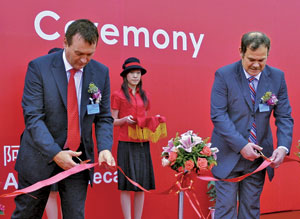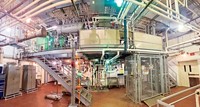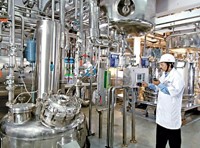Advertisement
Grab your lab coat. Let's get started
Welcome!
Welcome!
Create an account below to get 6 C&EN articles per month, receive newsletters and more - all free.
It seems this is your first time logging in online. Please enter the following information to continue.
As an ACS member you automatically get access to this site. All we need is few more details to create your reading experience.
Not you? Sign in with a different account.
Not you? Sign in with a different account.
ERROR 1
ERROR 1
ERROR 2
ERROR 2
ERROR 2
ERROR 2
ERROR 2
Password and Confirm password must match.
If you have an ACS member number, please enter it here so we can link this account to your membership. (optional)
ERROR 2
ACS values your privacy. By submitting your information, you are gaining access to C&EN and subscribing to our weekly newsletter. We use the information you provide to make your reading experience better, and we will never sell your data to third party members.
Business
AstraZeneca Leaves Manufacturing
British firm looks to China for its pharmaceutical chemical production needs
by Lisa M. Jarvis
July 30, 2007
| A version of this story appeared in
Volume 85, Issue 31

UNDER PRESSURE to shape up its R&D operations and produce more and better drugs, the pharma industry is beginning to back away from a jack-of-all-trades approach. A number of companies are paring down their internal manufacturing operations and getting comfortable with outsourcing the production of some of their most important pharmaceutical chemicals, even to low-cost regions such as China and India.
However, most drug firms are maintaining some level of internal production even after major cuts. For example, Merck is trimming 20% of its manufacturing sites and shedding some 7,000 production jobs, but it will still have a global network of 26 facilities. And in 2003, Pfizer began divesting or closing at least 29 sites, but the company still boasts more than 60 manufacturing facilities.
AstraZeneca is taking more extreme measures. The British firm has initiated a strategy to phase out internal manufacturing altogether. The shift coincides with a strong push into China, which the company sees as a major contributor to its chemical supply network in the future.
Today, AstraZeneca typically purchases drug raw materials and intermediates and then conducts the final stages of active pharmaceutical ingredient (API) synthesis at its own facilities, according to Steve N. Fishwick, the company's director of Asia sourcing. But in the next three to five years, AstraZeneca will stop launching any new APIs from its own sites. And over the next five to 10 years, the company plans to have exited API production entirely.
In the first phase of this strategy shift, the company will end API production in Macclesfield, England, and Plankstadt, Germany, and cut back operations in Sweden. Meanwhile, facilities in Bristol, England, and Dunkirk, France, will continue to run for the medium term. The firm will cut about 3,000 manufacturing jobs over the next three years as a result of the changes.
As AstraZeneca moves out of manufacturing, it is looking to chemical production partners in China and India. "Our plans in China and India are embryonic, but we see this as the way forward," says Marc Jones, the company's vice president of global external sourcing.
The company recently opened a sourcing center near Shanghai, complementing an existing office in Bangalore, India, from which AstraZeneca already purchases APIs. "Both countries are strong. If anything, India has had a longer history of API production, but China is coming along fast," Fishwick says.
By 2010, the company plans to make up to $100 million in purchases from China, four times its 2006 spending there. These purchases will include nonmanufactured products and services, and Fishwick stresses that the Shanghai staffers will do more than seek out chemical synthesis partners. They will look for "anything that AstraZeneca feels we could source from those areas," he says, ranging from raw materials to contract research to packaging to information technology.
James Bruno, director of the consulting firm Chemical & Pharmaceutical Solutions, notes that the push into China is not just about finding cheap labor or streamlining internal operations. The market research firm IMS Health predicts that China will be the world's seventh-largest drug market by 2010 and that planting roots there will provide easy access to a large, underserved population.
In fact, the sourcing center is part of a $100 million investment the British drug company plans to sink into China between 2006 and 2009; much of the money is earmarked for a research center focused on developing medicines for Chinese patients.
AstraZeneca's sourcing strategy underscores a growing comfort in the drug industry with transferring sensitive intellectual property to China and India. While Indian companies have come a long way in assuring big pharma that international laws will be respected there, China is considered more of a wild card. "I do believe that is changing," Fishwick says.
For example, Pfizer CentreSource, the custom manufacturing arm of the drug giant, has signed major supply pacts with ScinoPharm Taiwan and Shanghai Pharmaceutical Group for the production of 18 steroid APIs and intermediates. In that case, Pfizer has so far kept the most proprietary, early-phase steps of production at its site in Kalamazoo, Mich.
For its part, AstraZeneca has already enlisted one Chinese company to make lactam, an intermediate used in the manufacture of Seroquel, its drug for bipolar disorder. Fishwick declines to say whether AstraZeneca has contracts with Chinese suppliers to make APIs for any of its patented products, but the company appears prepared to bring all types of projects to the region. "We use the same rigorous process for assessing potential suppliers everywhere in the world," Fishwick says.
THE RESULT is what the company believes to be secure agreements tailored for the local legal environment. "But the thing we rely on most is building a mutually beneficial relationship with a supplier," he says. As such, the company's strategy "is not just to go out into the open market for spot business but to develop a strong relationship with a small number of suppliers," Fishwick adds.
While AstraZeneca is building a foundation in China and India, European manufacturers with competitive products or technologies will still find a place on its supplier list, Fishwick expects. "We will see continuing business with suppliers in Europe as well as in India and China, but clearly, in many areas of manufacturing, both India and China have increased dramatically in prominence," he adds.
Indeed, Fishwick's assertion that AstraZeneca will reap "significant cost savings" by buying APIs from Chinese fine chemicals companies could spell trouble for Western competitors. At the moment, the fine chemicals industry is benefiting from a broad new-drug pipeline composed of complex molecules that take many steps to synthesize, Bruno notes. Though there's work to go around, he cautions that "some of that chemistry that had gone to Europe eventually will be directed to China."







Join the conversation
Contact the reporter
Submit a Letter to the Editor for publication
Engage with us on Twitter